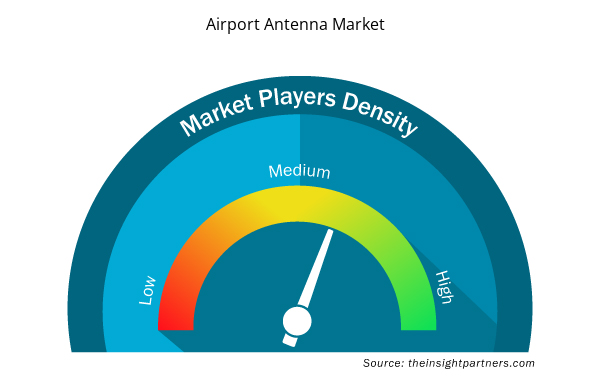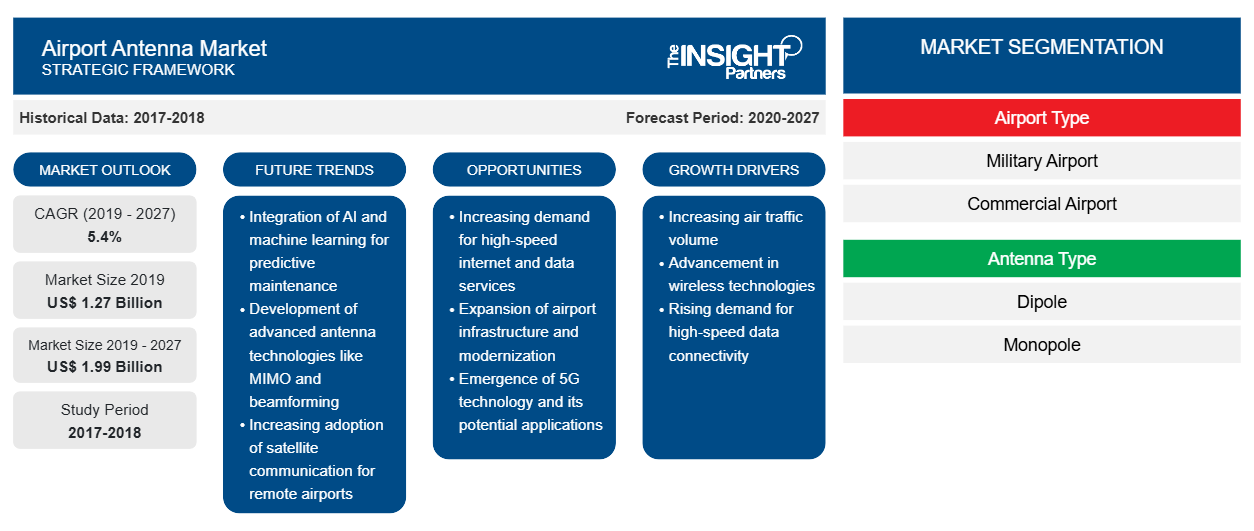2019 年机场天线市场价值为 12.7 亿美元,预计将达到到 2027 年将达到 19.9 亿;预计预测期内复合年增长率为 5.4%。
天线是一种接收和发送电信号的设备。天线在机场发挥着重要作用,有助于促进移动电话、卫星通信和无线局域网的发展。飞机使用射频天线导航目的地并与空中交通管制部门进行通信。机场天线主要用于军用机场和商用机场。在军用机场,天线通过引入高频、甚高频和超高频波段来增强通信。这些先进的天线解决方案提供车载、地面、机载和舰载应用,有助于展示多种军事行动。
由于世界各地新建和现有机场的建设和改造不断增加,机场天线系统的进步也在不断增加。随着乘坐飞机的乘客数量不断增加,机场大量部署了无线局域网 Wi-Fi 热点天线,为乘客提供高速互联网接入。2019 年 10 月,总部位于英国的 Mobile Mark, Inc. 为全球导航卫星系统 (GNSS) 和 Wi-Fi 设施提供了 5G 车队管理天线,可用于通信、公共安全和车队管理。
定制此报告以满足您的需求
您可以免费定制任何报告,包括本报告的部分内容、国家级分析、Excel 数据包,以及为初创企业和大学提供优惠和折扣
- 获取此报告的关键市场趋势。这个免费样品将包括数据分析,从市场趋势到估计和预测。
COVID-19 疫情对机场天线市场的影响
由于 COVID-19 疫情的影响,全球航空业是面临航班取消、国家临时封锁和乘客数量减少等严重影响的主要行业之一。根据国际民用航空组织 (ICAO) 的数据,2020 年的乘客数量与 2019 年相比下降了约 57%-60%,2020 年 1 月至 8 月的客运收入损失约为 2560 亿美元。因此,全球对机场基础设施建设的需求(包括机场天线的需求)急剧下降。此外,北美、欧洲、中东和非洲以及南美等主要地区开发天线组件、传感器、控制器和材料的各类工厂的关闭也影响了全球供应链,并对机场发展、新机场的建立和原材料产生了负面影响。
机场天线市场洞察
机场基础设施建设和现代化进程迅猛
由于全球航空旅客数量不断增长,各国政府都在致力于改善机场基础设施。根据国际航空运输协会 (IATA) 的 20 年估计,到 2037 年,全球航空旅客数量预计将达到约 82 亿,复合年增长率为 3.5%。根据 IATA 的计算,航空业预计将在未来 20 年实现强劲增长,并为生态系统中的各个利益相关者带来各种好处。预计北美的复合年增长率为 2.4%,约为 14 亿乘客,欧洲的复合年增长率为 2.0%,即预测期内约 19 亿乘客。不过,预计增长的很大一部分将来自世界东部。IATA 还估计,由于印度、新加坡、中国和日本等国家的航空运输量增长,预计亚太地区将成为全球航空业收入的主要贡献者。预计到 2037 年亚太地区的乘客数量将增加到 23.5 亿人次左右,到 2037 年将达到约 39 亿人次。
基于机场类型的市场洞察
根据机场类型,机场天线市场分为军用机场和商用机场。机场天线用于不同的应用,包括监视、导航和地对空通信。军用机场天线是按照军用标准专门设计的天线,与商用机场天线不同。全球军用和商用机场数量的不断增加是支持机场天线市场增长的主要因素之一。此外,机场天线市场的公司正专注于提供尖端解决方案,以满足商用和军用机场的特定需求。
基于天线类型的市场洞察
根据天线类型,机场天线市场分为单极天线和偶极天线。偶极天线用于机场的通信、监视和其他应用。单极天线适用于 RFID 和无线网络。在市场上运营的公司正专注于引入高效天线,以提高机场基础设施的性能。
基于频段的市场洞察
根据频段,机场天线市场分为高频 (HF)、甚高频 (VHF) 和超高频 (UHF)。HF 天线用于机场通信。VHF 和 UHF 天线用于点对点、地对空和空对地应用。市场上的公司提供各种配置、功能和特性的 HF、UHF 和 VHF 天线,以满足各种安装的需求。一些公司还提供定制产品以满足客户的特定需求。
基于应用的市场洞察
根据应用,机场天线市场分为卫星通信、监视、导航和其他。机场天线与各种机场基础设施集成,用于机场的不同应用。机场天线有助于避免碰撞、监控飞机和管理空中交通以提高机场效率。此外,不断增长的空中交通、不断增加的机场数量以及对飞机安全和改善空中交通流量的高度重视预计将支持对不同应用的机场天线日益增长的需求。在市场上运营的公司也在努力为不同的机场应用提供高效的天线,以获得强大的市场地位。
机场天线市场区域洞察
Insight Partners 的分析师已详细解释了预测期内影响机场天线市场的区域趋势和因素。本节还讨论了北美、欧洲、亚太地区、中东和非洲以及南美和中美洲的机场天线市场细分和地理位置。

- 获取机场天线市场的区域具体数据
机场天线市场报告范围
| 报告属性 | 细节 |
|---|---|
| 2019 年市场规模 | 12.7亿美元 |
| 2027 年市场规模 | 19.9亿美元 |
| 全球复合年增长率(2019 - 2027) | 5.4% |
| 史料 | 2017-2018 |
| 预测期 | 2020-2027 |
| 涵盖的领域 | 按机场类型
|
| 覆盖地区和国家 | 北美
|
| 市场领导者和主要公司简介 |
|
机场天线市场参与者密度:了解其对业务动态的影响
机场天线市场正在快速增长,这得益于终端用户需求的不断增长,而这些需求又源于消费者偏好的不断变化、技术进步以及对产品优势的认识不断提高等因素。随着需求的增加,企业正在扩大其产品范围,进行创新以满足消费者的需求,并利用新兴趋势,从而进一步推动市场增长。
市场参与者密度是指在特定市场或行业内运营的企业或公司的分布情况。它表明在给定市场空间中,相对于其规模或总市场价值,有多少竞争对手(市场参与者)存在。
在机场天线市场运营的主要公司有:
- 诺斯罗普·格鲁曼公司
- 科巴姆有限公司
- 韦德天线公司
- 安费诺普罗科
- 天线产品公司
免责声明:上面列出的公司没有按照任何特定顺序排列。

- 获取机场天线市场顶级关键参与者概览
机场天线市场的参与者专注于市场计划、收购和产品发布等策略,以保持其在市场中的地位。以下列出了一些主要参与者的发展:
2020 年,HENSOLDT 南非公司收购了国防和安全业务 Tellumat 和空中交通管理公司。这一战略将帮助 HENSOLDT 进一步扩大其投资组合以及在非洲的业务。
2019 年,NAV CANADA 在加拿大最大的机场多伦多投入了第一台 SCANTER 5502 固态地面运动雷达。该公司提供了新型加热防冰天线,可以防止天线在旋转时结冰。
机场天线市场 – 按机场类型
- 商业机场
- 军用机场
机场天线市场 – 按天线类型
- 偶极子
- 单极子
机场天线市场 – 按频段划分
- 高频
- 非常高的频率
- 超高频
机场天线市场——按应用划分
- 卫星通信
- 导航
- 监视
- 其他的
机场天线市场 – 按地区划分
北美
- 我们
- 加拿大
- 墨西哥
欧洲
- 英国
- 德国
- 法国
- 意大利
- 西班牙
- 瑞士
- 斯堪的纳维亚
- 欧洲其他地区
亚太地区 (APAC)
- 中国
- 日本
- 印度
- 澳大利亚
- 韩国
- 新加坡
- 马来西亚
- 泰国
- 亚太地区其他地区
中东和非洲 (MEA)
- 沙特阿拉伯
- 阿联酋
- 南非
- MEA 其他地区
南美洲 (SAM)
- 巴西
- 阿根廷
- 智利
- SAM 其余部分
机场天线市场 – 公司简介
- 诺斯罗普·格鲁曼公司
- 科巴姆有限公司
- 韦德天线公司
- 安费诺普罗科
- 天线产品公司
- 康罗德通讯公司
- 亨索尔特公司
- 罗德与施瓦茨有限公司
- 特玛
- 瓦茨天线公司
- 历史分析(2 年)、基准年、预测(7 年)及复合年增长率
- PEST 和 SWOT 分析
- 市场规模价值/数量 - 全球、区域、国家
- 行业和竞争格局
- Excel 数据集



Report Coverage
Revenue forecast, Company Analysis, Industry landscape, Growth factors, and Trends

Segment Covered
This text is related
to segments covered.

Regional Scope
North America, Europe, Asia Pacific, Middle East & Africa, South & Central America

Country Scope
This text is related
to country scope.
常见问题
The government of different countries is robustly investing toward the airport's expansion and construction to handle the increasing number of air passengers. According to IATA, ~US$ 1.2-1.5 trillion is estimated to be spent on the development of airport infrastructure across the world by 2030, which requires significant increases in capital spending. Several airport construction projects are ongoing across different countries, which demand the integration of innovative and advanced technological equipment to streamline the airport's overall operational efficiency.
A commercial airport is a public location, where the flight operations take place. The commercial airport includes various surveillance, navigation, and communication products that require different types of antennas.With the growing number of commercial airports worldwide, the demand for airport antennas is expected to grow. Countries such as China and India are witnessing significant growth in the commercial aviation industry, creating an opportunity for the companies operating in the market to achieve a substantial market share.
North America comprises of the largest fleet of commercial and defense aircraft in the world. Huge volumes of commercial and military fleets in operations in the domestic as well as international arena coupled with a high average passenger mile flown value in the region, propel the requirements for airport components. The countries in the region have a considerable presence of both military and commercial airports, some are upgrading with new technology, and some are still under-construction phase, thereby resulted in the region’s prominent market share in the global airport antenna market.
Trends and growth analysis reports related to Electronics and Semiconductor : READ MORE..
The List of Companies - Airport Antenna Market
- Northrop Grumman Corporation
- Cobham Limited
- Wade Antenna, Inc
- Amphenol Procom
- Antenna Product Corporation
- Comrod Communication AS
- HENSOLDT Inc
- Rohde & Schwarz GmbH & Co.
- Terma
- Watts Antenna Company
The Insight Partners performs research in 4 major stages: Data Collection & Secondary Research, Primary Research, Data Analysis and Data Triangulation & Final Review.
- Data Collection and Secondary Research:
As a market research and consulting firm operating from a decade, we have published and advised several client across the globe. First step for any study will start with an assessment of currently available data and insights from existing reports. Further, historical and current market information is collected from Investor Presentations, Annual Reports, SEC Filings, etc., and other information related to company’s performance and market positioning are gathered from Paid Databases (Factiva, Hoovers, and Reuters) and various other publications available in public domain.
Several associations trade associates, technical forums, institutes, societies and organization are accessed to gain technical as well as market related insights through their publications such as research papers, blogs and press releases related to the studies are referred to get cues about the market. Further, white papers, journals, magazines, and other news articles published in last 3 years are scrutinized and analyzed to understand the current market trends.
- Primary Research:
The primarily interview analysis comprise of data obtained from industry participants interview and answers to survey questions gathered by in-house primary team.
For primary research, interviews are conducted with industry experts/CEOs/Marketing Managers/VPs/Subject Matter Experts from both demand and supply side to get a 360-degree view of the market. The primary team conducts several interviews based on the complexity of the markets to understand the various market trends and dynamics which makes research more credible and precise.
A typical research interview fulfils the following functions:
- Provides first-hand information on the market size, market trends, growth trends, competitive landscape, and outlook
- Validates and strengthens in-house secondary research findings
- Develops the analysis team’s expertise and market understanding
Primary research involves email interactions and telephone interviews for each market, category, segment, and sub-segment across geographies. The participants who typically take part in such a process include, but are not limited to:
- Industry participants: VPs, business development managers, market intelligence managers and national sales managers
- Outside experts: Valuation experts, research analysts and key opinion leaders specializing in the electronics and semiconductor industry.
Below is the breakup of our primary respondents by company, designation, and region:

Once we receive the confirmation from primary research sources or primary respondents, we finalize the base year market estimation and forecast the data as per the macroeconomic and microeconomic factors assessed during data collection.
- Data Analysis:
Once data is validated through both secondary as well as primary respondents, we finalize the market estimations by hypothesis formulation and factor analysis at regional and country level.
- Macro-Economic Factor Analysis:
We analyse macroeconomic indicators such the gross domestic product (GDP), increase in the demand for goods and services across industries, technological advancement, regional economic growth, governmental policies, the influence of COVID-19, PEST analysis, and other aspects. This analysis aids in setting benchmarks for various nations/regions and approximating market splits. Additionally, the general trend of the aforementioned components aid in determining the market's development possibilities.
- Country Level Data:
Various factors that are especially aligned to the country are taken into account to determine the market size for a certain area and country, including the presence of vendors, such as headquarters and offices, the country's GDP, demand patterns, and industry growth. To comprehend the market dynamics for the nation, a number of growth variables, inhibitors, application areas, and current market trends are researched. The aforementioned elements aid in determining the country's overall market's growth potential.
- Company Profile:
The “Table of Contents” is formulated by listing and analyzing more than 25 - 30 companies operating in the market ecosystem across geographies. However, we profile only 10 companies as a standard practice in our syndicate reports. These 10 companies comprise leading, emerging, and regional players. Nonetheless, our analysis is not restricted to the 10 listed companies, we also analyze other companies present in the market to develop a holistic view and understand the prevailing trends. The “Company Profiles” section in the report covers key facts, business description, products & services, financial information, SWOT analysis, and key developments. The financial information presented is extracted from the annual reports and official documents of the publicly listed companies. Upon collecting the information for the sections of respective companies, we verify them via various primary sources and then compile the data in respective company profiles. The company level information helps us in deriving the base number as well as in forecasting the market size.
- Developing Base Number:
Aggregation of sales statistics (2020-2022) and macro-economic factor, and other secondary and primary research insights are utilized to arrive at base number and related market shares for 2022. The data gaps are identified in this step and relevant market data is analyzed, collected from paid primary interviews or databases. On finalizing the base year market size, forecasts are developed on the basis of macro-economic, industry and market growth factors and company level analysis.
- Data Triangulation and Final Review:
The market findings and base year market size calculations are validated from supply as well as demand side. Demand side validations are based on macro-economic factor analysis and benchmarks for respective regions and countries. In case of supply side validations, revenues of major companies are estimated (in case not available) based on industry benchmark, approximate number of employees, product portfolio, and primary interviews revenues are gathered. Further revenue from target product/service segment is assessed to avoid overshooting of market statistics. In case of heavy deviations between supply and demand side values, all thes steps are repeated to achieve synchronization.
We follow an iterative model, wherein we share our research findings with Subject Matter Experts (SME’s) and Key Opinion Leaders (KOLs) until consensus view of the market is not formulated – this model negates any drastic deviation in the opinions of experts. Only validated and universally acceptable research findings are quoted in our reports.
We have important check points that we use to validate our research findings – which we call – data triangulation, where we validate the information, we generate from secondary sources with primary interviews and then we re-validate with our internal data bases and Subject matter experts. This comprehensive model enables us to deliver high quality, reliable data in shortest possible time.


 获取此报告的免费样本
获取此报告的免费样本